Military career of Muhammad
The military career of Muhammad (c. 570 – 8 June 632), the final prophet of Islam, encompasses several expeditions and battles throughout the Hejaz region in the western Arabian Peninsula which took place in the final ten years of his life, from 622 to 632. His primary campaign was against his own tribe in Mecca, the Quraysh. Muhammad proclaimed prophethood around 610 and later migrated to Medina after being persecuted by the Quraysh in 622. After several battles against the Quraysh, Muhammad conquered Mecca in 630, ending his campaign against the tribe.
Muhammad | |
|---|---|
 Calligraphic representation of the name Muhammad | |
| Native name | أبو القاسم محمد بن عبدالله بن عبد المطلب (Abu al-Qasim Muhammad ibn 'Abdullah ibn Abd ul-Muttalib) |
| Birth name | محمد بن عبدالله (Muhammad ibn 'Abdullah) |
| Born | c. 570 Mecca |
| Died | 8 June 632 Medina |
| Buried | The Green Dome |
| Spouse(s) | Wives of Muhammad |
| Children | Muhammad's children |
| Signature | 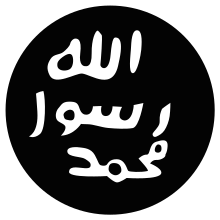 |
Alongside his campaign against the Quraysh, Muhammad led campaigns against several other tribes of Arabia, most notably the three Arabian Jewish tribes of Medina and the Jewish fortress at Khaybar. He expelled the Banu Qaynuqa tribe for violating the Constitution of Medina in 624, followed by the Banu Nadir who were expelled in May 625 after being accused of plotting to assassinate him. In early 627, he ordered the execution of all men and one woman of the Banu Qurayza tribe, who secretly made agreements with the Quraysh and their allies as they laid siege to Medina in the Battle of the Trench, violating the Constitution of Medina. Finally, in 628, he besieged and invaded the Jewish fortress of Khaybar, which hosted more than 10,000 Jews, which Muslims sources say was retaliation for planning to ally themselves with the local Arab pagan tribes.
In the final years of his life, Muhammad sent several armies against the Byzantine Empire and the Ghassanids in northern Arabia and the Levant, before conquering Mecca in 630 and leading a campaign against some Arab pagan tribes close to Mecca, most notably in Ta'if. The last army led by Muhammad before his death was in the Battle of Tabuk in October 630. By his death in 632, Muhammad had managed to unite most of the Arabian Peninsula, laying the foundation for the subsequent Islamic expansion under the caliphates and defining Islamic military jurisprudence.
Background
Muhammad's role in The Sacrilegious Wars
In his prophetic biography (Arabic: السيرة النبوية, romanized: as-Seerat un-Nabawiyyah) titled The Sealed Nectar (Arabic: الرحيق المختوم, romanized: ar-Rahiq al-Makhtum), Safiur Rahman Mubarakpuri cites Ibn Hisham in saying that Muhammad took part in the Sacrilegious Wars, which took place between an alliance of the Quraysh and the Kinanah and the Qais 'Ailan, when he was 15, saying that "his efforts were confined to picking up the arrows of the enemy as they fell, and handing them over to his uncles."[1]
Events before the Hijra
Muhammad proclaimed prophethood (nubuwwah) at the age of 40 to his tribe, the Quraysh, in Mecca. After his followers were persecuted by the Quraysh, Muhammad ordered them to move to Abyssinia to seek refuge in 615, where they were welcomed with open arms. After the death of his uncle Abu Talib in 619, Muhammad, the prophet of Islam, was lacking someone who provided him security in an increasingly hostile environment in Mecca. After several failed attempts to reach for tribes outside of Mecca, he contacted the Khazraj of Medina (then Yathrib). Six of them converted to Islam.[1][2]
In Medina they spread the word of Muhammad and Islam and in February 621, a new delegation reached Mecca, among them two members of the Aws. The Khazraj and Aws were rivals at this time, fighting for control of Medina. Muhammad mediated a ceasefire between the two parties and sent them back to Medina, accompanied by a reciter of the Quran. Islam slowly grew in Medina before in March 622, a new delegation, this time numbering 72 people, consulted with Muhammad. They pledged their readiness to wage war against Muhammad's enemies, while Muhammad also declared his readiness to wage war against the Jews of Medina.[lower-alpha 1] The Meccans, who heard rumours of this meeting and realized that this was a call to war, failed an attempt to assassinate Muhammad in May 622. Muhammad fled, together with his companion Abu Bakr, to Medina, in what is known as the Hijra.[1][2]
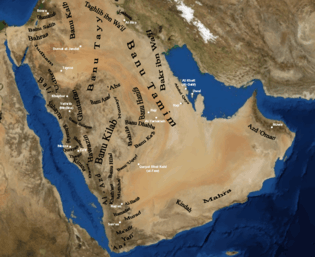
Situation in Medina
Medina was divided into five tribes: two of them the Khazraj and Aws, while the Jews were represented by, from smallest to largest, the Banu Qaynuqa, Banu Nadir and Banu Quraizah.[1][4] Upon his arrival in Medina, Muhammad set about the establishment of a pact known as the Constitution of Medina, to regulate the matters of governance of the city, as well as the extent and nature of inter-community relations, and signatories to it included the Muslims, the Ansar and the Jewish tribes of Medina.[5] Significant clauses of the constitution included the mutual assistance of each other if one signatory were to be attacked by a third party, the resolution that the Muslims would profess their religion and the Jews theirs, as well as the appointment of Muhammad as the leader of the state.[6]
History
Campaign against the Quraysh
Caravan raids prior to Badr
| Part of a series on |
| Muhammad |
|---|
 |
|
Views |
|
Related |
|
Muhammad and his companions soon engaged in a series of caravan raids. These raids were generally offensive[7] and carried out to gather intelligence or seize the trade goods of caravans financed by the Quraysh (such retaliation was explained as being legitimate by saying many Muslims' possessions and wealth, left behind when they migrated from Mecca, were stolen).[1][8][9] The Muslims declared that the raids were justified and that God gave them permission to defend against the Meccans' persecution of Muslims.[10][11] Another reason for the raids appears to have been economic stress, as the food output of Medina was barely capable of feeding the Muslim newcomers. Hence, the raiding of food was mandatory to supplement their diet.[12]
The order of the caravan raids is somewhat confused in the Islamic sources. What seems clear is that there were two types of raids: those led by Muhammad and those led by lieutenants. They featured somewhere between seven and 200 warriors, typically on foot,[13] but occasionally horse riders.[1] These fighters were, at least initially, provided almost exclusively by the Muhajirun, the Muslim migrants from Mecca. Consisting primarily of unemployed young men, they had the chance to place their name in a register if desiring to go on a raid.[14]
The first year of these raids was a "near total failure".[15] All Meccan caravans managed to evade Muhammad's forces or were accompanied by forces with superior numbers, suggesting that the Quraish relied on a spy among the core of the Muslim community. Aware of this problem, Muhammad introduced the usage of sealed letters of instructions and appointed 'Abdullah ibn Jahsh to lead an expedition of eight or twelve men. After marching for two days, Ibn Jahsh opened the letter to learn that, according to most sources, he was instructed to gain intelligence information about the movement of Meccan caravans deep in Quraish territory, in Nakhlah, near modern-day Rabigh. Soon the expedition met a Meccan caravan, weakly protected by only four guards. The Muslims encountered the caravan in a holy month where fighting was forbidden, and it also seems that Muhammad did not order the usage of violence. Despite this, the Muslim warriors collectively decided to attack and approached the caravan disguised as pilgrims. When close enough they leaped upon the guards: one of whom escaped, two were seized and one was killed.[16] The victim, named Amr ibn al-Hadrami, was the first person killed for the cause of Islam.[17] Ibn Jahsh and his men returned to Medina with the seized caravan,[18] which carried wine, leather goods and raisins.[19]
Battle of Badr
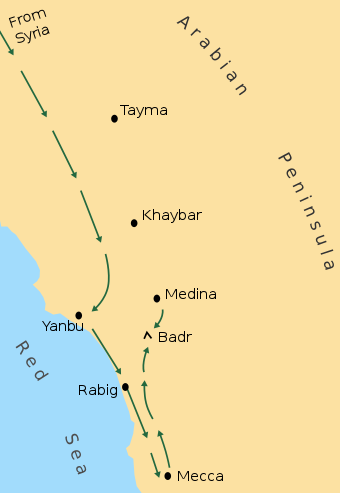
On 13 March 624 (17 Ramadan 2 AH), Muhammad faced the Meccans in the first pitched battle, the Battle of Badr.[1] The prelude revolved around Muhammad's plan to raid a major Meccan caravan which was on its way from Syria to Mecca. It was of monumental size, comprising 1000 camels transporting tens of thousands of dinars, and was escorted by 70 horsemen. Attacking this caravan would have forced Mecca into action, as virtually every Qurayshi family had invested in it. Despite this risk, Muhammad began the preparations before finally setting out on 9 December 623, with a force of around 313-317 men, 70 camels and two horses. Muhammad and his warriors marched offside the common roads to avoid Meccan scouts, passing through little-known canyons and wadis.[20]
The Qurayshi leader of the caravan, Abu Sufyan ibn Harb, who accompanied the caravan and realized that Muslim scouts were nearby, ordered the caravan to take a different route and sent a messenger to Mecca. After the latter arrived in Mecca and told the Quraysh that a Muslim attack was imminent, a Meccan relief force of more than 1000 men, many of them wearing chainmail armour, was sent. Amr ibn Hisham, who was later given the kunya Abu Jahl by Muhammad, who led the relief army, pressed northwards to where he expected the Muslim army to be: at Badr. While marching, however, around 200–400 warriors left his army and headed back to Mecca.[21]
.jpg)
Muhammad was unaware of the Meccan army until one day before contact, when his men captured two Qurayshi waterbearers.[22] The Muslims took up a defensive position. The battle started off with a duel between three Muslim and three Meccan champions, which the Muslims decided in their favour. Afterwards the two armies exchanged arrow fire, before finally clashing.[23] According to the Quran,[lower-alpha 2] thousands of angels descended from heaven and participated in the battle, being instructed by Allah to "smite the [Meccan warriors'] necks and smite of them each finger."[lower-alpha 3] According to another Quranic verse,[lower-alpha 4] Allah fought and killed the Meccans representatively for the Muslim warriors.[27]
The Meccan army eventually collapsed soon after the horse of Abu Jahl was brought down,[28] resulting in the first major Muslim victory.[29] This victory must not so much be ascribed to divine intervention as is done in the Islamic sources, but had several conventional reasons, like the Meccan inability to use their cavalry, the questioned leadership of Abu Jahl,[lower-alpha 5] the Meccan lack of access to water and the higher morale of the Muslims.[31] The battle took the lives of 14 Muslims, while the Meccan casualties numbered between 50 and 70. A similar number of them were captured and were either executed or kept for ransom.[29] Amr ibn Hisham survived the battle, but with mortal injuries. A Muslim warrior found him, decapitated him and presented his head to Muhammad. Many more noblemen of the Quraysh had died in the fighting, which posed a significant blow to the Quraysh.[32] Muhammad thought about pursuing the Meccan caravan, but then decided to return to Medina instead.[33]
'Battle of Uhud
In December 624 CE (Shawwal 3 AH), Abu Sufyan ibn Harb, now the de facto leader of Mecca, marched upon Medina with an army of 3,000 men to avenge the losses at Badr. Learning of his movement toward Medina, Muhammad held a council of war at Medina to debate whether to fight from inside the walls of Medina or to go out and face the Meccan army. After he reached a consensus between the Ansar and the Muhajirun to meet the enemy outside the walls of the city, Muhammad marched with a 1,000-strong army toward the mountain of Uhud.
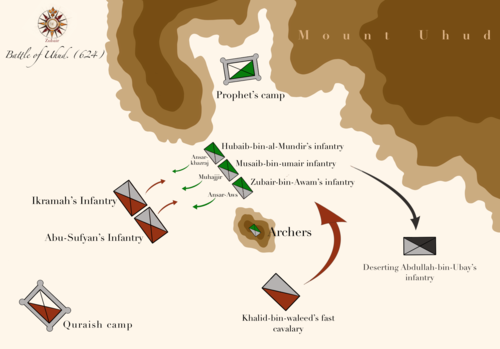
As the Muslim army approached Uhud, 300 of them withdrew under 'Abdullah ibn Ubayy, leaving the Muslims numbering around 700. The battle was the first defensive battle in which Muhammad took part. Muhammad anticipated the Quraysh to try to encircle the Muslims from around a small mount to the south of Uhud, and thus, placed 50 archers on the small mountain, now called Jabal ar-Rumma (Mount of the Archers), to protect the Muslims' left flank.

Seeing that the Muslims were gaining the initiative early in the battle, around 40 of the archers disobeyed Muhammad's commands and climbed down the hill to collect the spoils of war. Khalid ibn al-Walid, who was still not a Muslim then and was a commander of the right cavalry flank of the Meccans, exploited this mistake and tried to encircle the Muslims, which led to the slaughter of most of those who had climbed down. Seeing that his army had now been encircled, Muhammad himself entered the battlefield and started to fight to save the Muslims, but he got injured on his shoulder and his lower right tooth was broken.
Many see the Battle of Uhud as a stalemate between the Meccans and the Muslims as the Meccans had achieved a tactical victory as their main objective was to avenge their losses at Badr, and they had killed and equal number of Muslims to that of the Meccans at Badr; but they failed to exploit their advantage and invade Medina. Muhammad lost his uncle, Hamza ibn Abdul-Muttalib, in the battle.
Battle of the Trench
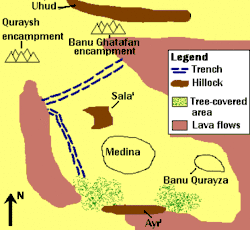
In December 626, Abu Sufyan ibn Harb led a confederate army of the Quraysh, the Banu Kinanah, the Ghatafan and the Banu Nadir, the exiled Jewish tribe from Medina, numbering around 10,000, to besiege Medina. Muhammad was able to prepare a force of about 3,000 men, and held another council of war to decide the course of action. Adopting a new form of defence, unknown in Arabia at that time, Muslims dug trenches wherever Medina lay open to cavalry attack. The idea is credited to a Persian convert to Islam, Salman al-Farsi.
The digging of the trench began on Monday, 29 December 626 (5 Shawwal AH 5) and took six days. On Saturday 3 January 627 (10 Shawwal 5 AH), the confederates encamped and Muhammad rode out at the head of his army to confront them. The siege lasted twenty nights,[34] until the early morning of Saturday, 24 January (1 Dhu al-Qa'dah), not two weeks as claimed by Watt.[35] Watt's date of 14 April for the end of the siege is also incorrect, being according to the fixed calendar which was not introduced for another five years. Abu Sufyan's troops were unprepared for the fortifications they were confronted with, and after an ineffectual siege, the coalition decided to go home.[36] The campaign lasted 27 days. The immediate cause was harsh winter weather, making the mid-April date inconceivable.[37] The Qur'an discusses this battle in verses 9-27 of surah 33, Al-Ahzab.[38][39]
Treaty of Hudaybiyyah
According to traditional Arabian customs, during the months of pilgrimage and the sacred months, tribal hostilities stopped and all were free to visit Mecca. In March 628, Muhammad put on the ihram and led a contingent of Muslims and camels for sacrifice toward Mecca intending to perform the Hajj pilgrimage.[40] According to the early chronicler Ibn Ishaq, Muhammad took 700 men.[41] According to Watt, Muhammad took 1400 to 1600 men.[42] The Meccans did not accept the Muslim professions of peaceful intent and sent out an armed party against them. The Muslims evaded them by taking an unconventional route through the hills around Mecca, and then camped outside Mecca, at Hudaybiyyah. Ibn Ishaq describes a tense period of embassies and counter-embassies, including a bold foray by the future caliph, 'Uthman ibn Affan, into the city of Mecca, where he was temporarily held as a hostage. The Meccans told the Muslims that 'Uthman had been killed and open warfare seemed imminent. After it was revealed that 'Uthman was alive, the Meccans expressed their willingness to negotiate a truce. Some elements wanted a confrontation, but Muhammad held out for a peaceful resolution. The treaty of Hudaybiyyah committed both sides and their allies to a ten-year truce. The Muslims were to be allowed to return the next year, to perform the pilgrimage.
Conquest of Mecca

Less than two years after the truce of Hudaybiyyah, the truce was broken by the Banu Bakr, allies of the Quraysh, who attacked the Banū Khuzaʽah, allies of the Muslims. According to Watt, Some of the Quraysh helped the Banu Bakr ambush the Khuza'ah. Muhammad gave the Meccans a chance to offer blood-money in retaliation, but they were unwilling to do so. Shortly afterwards, Muhammad secretly led a Muslim force of 10,000 men and headed for Mecca. They camped outside Mecca and the usual round of emissaries and negotiations began. Apparently Abu Sufyan had negotiated, then or earlier, a promise that he and those under him would not be attacked if they surrendered peacefully. A few Meccans from the Makhzum faction, prepared to resist.
On or near 11 January 630, Muhammad sent multiple columns of troops into Mecca. Only one column met any resistance. 28 Meccans were killed and the rest of those opposing the Muslim entry fled. The remaining Meccans surrendered to Muhammad. Some of the Meccans, even those who had been notable for their opposition to Islam, were spared.[43] The Kaaba was cleansed of all the idols of Arabian gods, such as Hubal, which were placed in it and the area was established as a Muslim sanctuary.[44] While destroying each idol, Muhammad recited verse 81 of Surah 17:[45][46]
"And say: Truth hath come and falsehood hath vanished away. Lo! falsehood is ever bound to vanish."[47]
However, according to one Shia tradition, he ordered an iconography of the virgin Mary and baby Jesus which was in the Kaaba not to be destroyed.[48]
Campaign against the Jews of Medina
Expulsion of the Banu Qaynuqa'
In April 624, after the Battle of Badr, the Banu Qaynuqa violated the Constitution of Medina by shaming a Muslim woman by pinning and tearing her clothes. A Muslim man who witnessed this, killed the Jewish man responsible for it in retaliation. The Jews came in group against the Muslim and killed him. After a successive chain of similar revenge killings, enmity grew between Muslims and the Banu Qaynuqa', which led Muhammad to lay siege to their fortress. The Qaynuqa' had a strength of around 700. After being besieged for 14-15 days, the tribe eventually surrendered to Muhammad, who initially wanted to capture the men of Banu Qaynuqa', but ultimately yielded to Abdullah ibn 'Ubayy and agreed to expel the Qaynuqa'. The tribe eventually went northward toward Der'aa in modern-day Syria and assimilated themselves into the local Jewish population.

Expulsion of the Banu Nadir
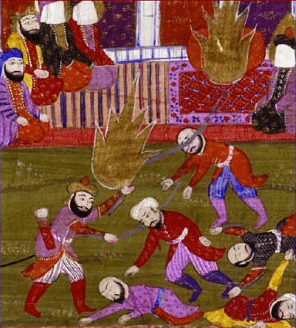
In May 625, Muhammad laid siege to the Banu Nadir, after they were accused of plotting to assassinate him. The siege is said to have lasted anywhere between six and fifteen days. Enjoying their strategic advantage due to the thick foliage of palm trees surrounding their castles, the Banu Nadir pelted the Muslims with stones and showered arrows upon them from their castles. In response, Muhammad is said to have commanded the burning of the palm trees. The tribe eventually surrendered and was expelled, moving northward toward Khaybar, another Jewish fort city around 150 km (95 mi) north of Medina and was captured again during the Battle of Khaybar. They were allowed to live around Khaybar until the Rashidun caliph, 'Umar ibn al-Khattab, expelled them for a second time.
Invasion of the Banu Qurayza
During the Battle of the Trench in December 626 and January 627, the Jewish tribe of Banu Qurayza, whose forts were located in southern Medina, were caught conspiring to ally themselves with the confederates and were charged with treachery. After the retreat of the coalition, Muslims besieged their forts, and they were the last of the Jewish tribes of Medina. The Banu Qurayza surrendered and all the men and one woman were beheaded, apart from a few who converted to Islam, while all the other women and children were enslaved.[49][50]
In dealing with Muhammad's treatment of the Jews of Medina, aside from political explanations, western historians and biographers have explained it as "the punishment of the Medinan Jews, who were invited to convert and refused, perfectly exemplify the Quran's tales of what happened to those who rejected the prophets of old."[51] Francis Edward Peters adds that Muhammad was possibly emboldened by his military successes and also wanted to push his advantage. Economical motivations according to Peters also existed since the poorness of the Meccan migrants was a source of concern for Muhammad.[52] Peters argues that Muhammad's treatment of the Jews of Medina was "quite extraordinary" and is "quite at odds with Muhammad's treatment of the Jews he encountered outside Medina."[53]
According to Welch, Muhammad's treatment of the three major Jewish tribes brought Muhammad closer to his goal of organizing a community strictly on a religious basis.[54]
Siege of Khaybar
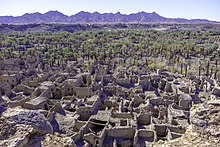
In March 628, according to Muslims sources, the Jews of Khaybar, along with the Banu Nadir, who were exiled from Medina by Muhammad for violating the Constitution of Medina, and the Banu Ghatafan, were planning to attack the Muslims. When Muhammad learned of their alliance, he gathered an army of 1,500 soldiers and besieged the Jewish fortress at Khaybar. Scottish historian and orientalist, William Montgomery Watt agrees with this view. Italian orientalist Laura Veccia Vaglieri claims other motives pushed Muhammad to invade the forts of Khaybar.
On the other side, the Banu Ghatafan were afraid that the Muslims would attack them at any time, so they refused to help the Jews at Khaybar. After capturing six of the eight Jewish forts in Medina, the Jews of Khaybar finally surrendered and were allowed to live in the oasis on the condition that they would give one-half of their produce to the Muslims. Two Jewish commanders were killed in the siege.
They continued to live in the oasis for several more years until they were expelled by caliph 'Umar ibn al-Khattab. The imposition of tribute upon the conquered Jews served as a precedent for provisions in the Islamic law for the jizya.
.jpg)
Byzantine campaign
In the final years of his life, after suppressing the two main factions that were leading in the opposition against him; the Meccans and the Jews, Muhammad led an active campaign against the main force in the north, the Byzantine Empire, which was involved in several wars against the Sasanian Empire, known as the Roman–Persian Wars.
Following a defeat in the Battle of Mu'tah in Muhammad's campaign against the Byzantine began with the final expedition led by Muhammad himself, the Tabuk expedition, which is also known as the Usra expedition. Muhammad heard of the gathering of a large Byzantine–Ghassanid alliance against the Muslims in Tabuk and led a force of some 30,000 men to look for them. After waiting and scouting for the enemy for twenty days, Muhammad returned to Medina.
Statistics
The total of all casualties on all sides in all the battles of Muhammad might be, more or less, 1000. A contemporary Islamic scholar, Maulana Wahiduddin Khan, says that "during the 23-years in which this revolution was completed, 80 military expeditions took place. Fewer than 20 expeditions actually involved any fighting. 259 Muslims and 759 non-Muslims died in these battles – a total of 1018 dead."[55]
Legacy
Javed Ahmed Ghamidi writes in Mizan that there are certain directives of the Qur’an pertaining to war which were specific only to Muhammad against divinely-specified peoples of his times (the polytheists and the Israelites and Nazarites of Arabia and some other Jews, Christians, et al.) as a form of divine punishment—for they had persistently denied the truth of Muhammad's mission even after it had been made conclusively evident to them by Allah through Muhammad, and asked the polytheists of Arabia for submission to Islam as a condition for exoneration and the others for jizya and submission to the political authority of the Muslims for military protection as the dhimmis of the Muslims. Therefore, after Muhammad and his companions, there is no concept in Islam obliging Muslims to wage war for propagation or implementation of Islam, hence now, the only valid reason for war is to end oppression when all other measures have failed or, jihad.[56][57]
List of expeditions of Muhammad
| Name | Name | Leader | Location | C.E. date | Outcome | Notes |
|---|---|---|---|---|---|---|
| 1 | Seef ul-Bahr expedition | Hamza ibn 'Abdul-Muttalib | al-'Is | March 623 | No combat | |
| 2 | Batn Rabigh expedition | 'Ubaydah ibn al-Harith | Rabigh | April 623 | No combat | |
| 3 | al-Kharrar expedition | May 623 | No combat | |||
| 4(1) | Waddan patrol | Muhammad | al-Abwa' | August 623 | No combat | Alliance with Banu Damrah established |
| 5(2) | Buwat patrol | Buwat | September 623 | No combat | ||
| 6(3) | Safwan patrol (1st Badr) | Badr | September 623
(Rabi' I 2 AH) |
No combat | ||
| 7(4) | Patrol of Dhu al-'Ushairah | December 623 | No combat | Alliance with Banu Mudlij established | ||
| 8 | 1st Nakhlah Raid | 'Abdullah ibn Jahsh al-Asadi | Nakhlah | January 624 | Success | First successful raid |
| 9(5) | Badr al-Kubra' (2nd Badr) | Muhammad | Badr | 13 March 624
(17 Ramadan 2 AH) |
Victory | First victory |
| 10 | Killing of Asma bint Marwan | Medina | March 624 | Success | Asma' bint Marwan killed | |
| 11 | Killing of Abu Afak | March 624 | Success | Abu 'Afak killed | ||
| 12(6) | Invasion of Banu Qaynuqa | Muhammad | Medina | April 624 | Victory | Banu Qaynuqa' sent into exile |
| 13(7) | Sawiq patrol | May/June 624 | Defeat | Abu Sufyan ibn Harb burns 'Urayd farms; kills two Muslims | ||
| 14(8) | Al Kudr Invasion | Al Kudr | May 624 | Victory | ||
| 15 | Killing of Ka'b ibn al-Ashraf | August/September 624 | Success | Ka'b ibn al-Ashraf killed | ||
| 16(9) | Dhu 'Amar raid | Muhammad | September 624 | Success | ||
| 17(10) | Buhran patrol | Buhran | October/November 624 | No combat | ||
| 18 | al-Qarada raid | al-Qarada
(in Najd) |
November 624 | Success | ||
| 19(11) | Battle of Uhud | Muhammad | Mount Uhud
(near Medina) |
23 March 625 | Stalemate | Tactical defeat; second major battle against the Meccans |
| 20(12) | Battle of Hamra' al-Asad | Hamra' al-Asad
(near Medina) |
March 625 | Stalemate | ||
| 21 | Qatan expedition | Abu Salama 'Abdullah ibn 'Abd al-Asad | Qatan | June 625 | No combat | |
| 22 | Killing of Sufyan ibn Khaled | Abdullah ibn Unais | June 625 | Success | Sufyan ibn Khaled, chief of the Banu Lahyan, is killed | |
| 23 | al-Raji expedition | al-Raji | July 625 | Defeat | Banu Lahyan kill Muslim missionaries to avenge the killing of Sufyan ibn Khaled | |
| 24 | Bi'r Ma'ona expedition | Bi'r Ma'ona | July 625 | Defeat | Banu Amir kill Muslim missionaries | |
| 25(13) | Invasion of Banu Nadir | Muhammad | Medina | August 625 | Victory | Banu Nadir sent into exile |
| 26(14) | Badr al-Maw'id expedition | Badr | April 626 | Victory | ||
| 27(15) | Dhat al-Riqa' expedition | Dhat al-Riqa' | June 626 | No combat | ||
| 28(16) | 1st Daumat al-Jandal expedition | Daumat al-Jandal | August/September 626 | No combat | ||
| 29 | al-Muraysi' expedition | January 627 | Victory | |||
| 30(17) | Battle of the Trench | Muhammad | Medina | April 627 | Victory | |
| 31(18) | Invasion of Banu Qurayza | May 627 | Victory | Men of the Banu Qurayza' executed; women and children enslaved | ||
| 32 | Dir'iyah raid | Muhammad ibn Maslamah | Dir'iyah | June 627 | Victory | |
| 33(19) | Invasion of Banu Lahyan | Muhammad | Batn Gharran | July 627 | No combat | |
| 34 | Dhu Qarad expedition | Dhu Qarad | August 627 | Partial success | ||
| 35 | 2nd Banu Asad raid | Ukasha ibn al-Mihsan | Ghamrah | August/September 627 | ||
| 36 | 1st Banu Tha'labah raid | August/September 627 | ||||
| 37 | 2nd Banu Tha'labah raid | August/September 627 | ||||
| 38 | al-Jumum expedition | Zayd ibn Harithah | Al Jumum | September 627 | ||
| 39 | al-'Is expedition | September/October 627 | ||||
| 40 | 3rd Banu Tha'labah raid | October/November 627 | ||||
| 41 | Hisma expedition | Zayd ibn Harithah | October/November 627 | |||
| 42 | Wadi al-Qurra' expedition | Wadi al-Qurra' | November/December 627 | |||
| 43 | 2nd Daumat al-Jandal expedition | 'Abd al-Rahman ibn 'Awf | Daumat al-Jandal | December 627/January 628 | ||
| 44 | 1st Fidak expedition | Fidak | December 627/January 628 | |||
| 45 | 2nd Wadi al-Qurra' expedition | Zayd ibn Harithah | Wadi al-Qurra' | 628 | ||
| 46 | Banu 'Uraynah raid | Kurz ibn Jabir al-Fihri | January/February 628 | |||
| 47 | Expedition of Abdullah ibn Rawaha | 'Abdullah ibn Rawaha | February/March 628 | |||
| 48(20) | Treaty of Hudaybiyyah | Muhammad | March 628 | 10-year truce signed | ||
| 49(21) | Conquest of Fidak | 'Ali ibn Abu Talib | Fidak | May 628 | Victory | |
| 50(22) | Battle of Khaybar | Muhammad | Khaybar | May/June 628 | Victory | |
| 51(23) | 3rd Wadi al-Qurra' expedition | Wadi al-Qurra' | May 628 | |||
| 52 | Turbah expedition | 'Umar ibn al-Khattab | Turbah | December 628 | ||
| 53 | Najd expedition | Abu Bakr as-Siddiq | Najd | December 628 | ||
| 54 | Fidak expedition | Bashir ibn Sa'ad al-Ansari | Fidak | December 628 | ||
| 55 | Mayfah expedition | Ghalib ibn 'Abdullah al-Laythi | January 629 | |||
| 56 | Yemen expedition | Bashir ibn Sa'ad al-Ansari | Yemen | February 629 | ||
| 57 | Banu Sulaym expedition | Ibn Abi al-Awja' al-Sulami | April 629 | |||
| 58 | 2nd Fidak expedition | Ghalib ibn 'Abdullah al-Laythi | Fidak | May 629 | ||
| 59 | al-Kadid expedition | June 629 | ||||
| 60 | al-Siyii expedition | Shuja' ibn Wahb al-Asadi | June 629 | |||
| 61 | Dhat 'Atlah expedition | Ka'b ibn 'Umair al-Ghirfari | July 629 | |||
| 62 | Battle of Mu'tah | Zayd ibn Harithah | Mu'tah | September 629 | Defeat | Three major Muslim generals killed |
| 63 | Dhat as-Salasil expedition | 'Amr ibn al-'As | October 629 | |||
| 64 | al-Khabt expedition | Abu 'Ubaidah ibn al-Jarrah | October 629 | |||
| 65 | al-Ghaba expedition | Abu Hadrad al-Aslami | 629 | |||
| 66 | Khadirah expedition | Abu Qatadah ibn Rab'i al-Ansari | December 629 | |||
| 67 | Batn 'Edam expedition | December 629 | ||||
| 68(24) | Conquest of Mecca | Muhammad | Mecca | January 630 | Victory | |
| 69 | Nakhlah expedition | Nakhlah | January 630 | |||
| 70 | Ruhat raid | Ruhat
(near Mecca) |
January 630 | Victory | ||
| 71 | al-Mashallal raid | al-Mashallal
(near Mecca) |
January 630 | |||
| 72 | Banu Jadhimah raid | Khalid ibn al-Walid | January 630 | |||
| 73(25) | Battle of Hunayn | Muhammad | Hunayn (near Mecca) | January 630 | Victory | |
| 74 | Dhu al-Kaffain expedition | Tufayl ibn 'Amr ad-Dausi | January 630 | Victory | ||
| 75(26) | Battle of Autas | Muhammad | Autas | 630 | Victory | |
| 76 | 1st Autas expedition | Abu Amir al-Ash'ari | January 630 | |||
| 77 | 2nd Autas expedition | Abu Musa al-Ash'ari | January 630 | |||
| 78(27) | Siege of Ta'if | Muhammad | February 630 | Inconclusive | ||
| 79 | Expedition of Uyainah bin Hisn | April/May 630 | ||||
| 80 | Expedition of Qutbah ibn Amir | May/June 630 | ||||
| 81 | Expedition of Dahhak al-Kilabi | June/July 630 | ||||
| 82 | Expedition of Alqammah bin Mujazziz | July/August 630 | ||||
| 83 | al-Fuls expedition | 'Ali ibn Abu Talib | July/August 630 | |||
| 84 | 'Udhrah and Baliyy expedition | Ukasha ibn al-Mihsan | 630 | |||
| 85(28) | Tabuk expedition | Muhammad | October/December 630 | Inconclusive | ||
| 86 | 3rd Daumat al-Jandal expedition | Khalid ibn al-Walid | Daumat al-Jandal | October 630 | 9 | |
| 87 | Expedition of Abu Sufyan ibn Harb | Abu Sufyan ibn Harb | 630 | 9 | ||
| 88 | Demolition of Masjid al-Dirar | Medina | 630 | Victory | ||
| 89 | 2nd Daumat al-Jandal expedition | Khalid ibn al-Walid | Daumat al-Jandal | April 631 | 9 | |
| 90 | Expedition of Surad ibn Abdullah | Surad ibn 'Abdullah | April 631 | 9 | ||
| 91 | Najran expedition | Khalid ibn al-Walid | Najran | June/July 631 | 10 | |
| 92 | Mudhij expedition | 'Ali ibn Abu Talib | December 631 | 10 | ||
| 93 | Hamdan expedition | 632 | 10 | |||
| 94 | Demolition of Dhu al-Khalasa | April 632 | 10 | |||
| 95 | Balqa' expedition | Usama ibn Zayd | Balqa' | May 632 | 10 |
See also
- Book:Military career of Muhammad
- Rules of war in Islam
- Jihad
- Itmaam-i-hujjat
- Muslim conquests
Annotations
- "Its declaration to wage war against Muhammad's enemies was one crucial aspect of the Second Pledge of al-Aqaba. (....) During the negotiations before the pledge was made, one of the members of the Madinah delegation asked the Prophet about previous alliances they had made with the Jews [of Medina], expressing his concern that once Muhammad was victiorious, he might leave them to face the defeated Jews alone. To this the Prophet declared that "I will war against them that war against you and be at peace with those at peace with you." The implication was clear: The Second Pledge of al-Aqaba was against any who opposed Islam, and this pledge would invalidate previous treaties–principally those with the Jews of Madinah."[3]
- "Allah had already given you the victory at Badr, when ye were contemptible. So observe your duty to Allah in order that ye may be thankful.(3:123) When thou didst say unto the believers: Is it not sufficient for you that your Lord should support you with three thousand angels sent down (to your help)?(3:124) Nay, but if ye persevere, and keep from evil, and (the enemy) attack you suddenly, your Lord will help you with five thousand angels sweeping on."(3:125)[24]
- "When thy Lord inspired the angels, (saying): I am with you. So make those who believe stand firm. I will throw fear into the hearts of those who disbelieve.Then smite the necks and smite of them each finger."(8:12)[25]
- "Ye (Muslims) slew them not, but Allah slew them. And thou (Muhammad) threwest not when thou didst throw, but Allah threw, that He might test the believers by a fair test from Him. Lo! Allah is Hearer, Knower."(8:17)[26]
- Abu Jahl's initial task was merely the protection of the caravan, but he decided to bring the confrontation to the Muslims, possibly for the gain of glory or because he realized the need to extinguish the Muslim insurgency.[30] The behaviour of Abu Jahl eventually resulted in divisions among the Quraysh warriors.[31]
Notes
- Mubārakfūrī, Ṣafī al-Raḥmān. (2002). Ar-Raheeq Al-Mak̲h̲tūm = the sealed nectar : biography of the noble prophet (Rev. ed ed.). Riyadh, Saudi Arabia. ISBN 9960-899-55-1. OCLC 223400876.CS1 maint: extra text (link)
- Rodgers 2012, pp. 45–50.
- Rodgers 2012, p. 48.
- Rodgers 2012, p. 54.
- Ibn Hisham, as-Seerat an-Nabawiyyah, Vol. I p. 501.
- al-Mubarakpuri (2002) p. 230.
- Montgomery Watt, William (21 January 2010). Muhammad: prophet and statesman. Oxford University Press, 1974. p. 105. ISBN 978-0-19-881078-0.
- Mubarakpuri, Safiur-Rahman. When the moon split (PDF). Riyadh. p. 146.
- Gabriel, Richard A. (2008), Muhammad, Islam's first general, University of Oklahoma Press, p. 73, ISBN 978-0-8061-3860-2.
- Welch, Muhammad, Encyclopedia of Islam.
- See:
- Watt (1964) p. 76;
- Peters (1999) p. 172
- Michael Cook, Muhammad. In Founders of Faith, Oxford University Press, 1986, page 309.
- Rodgers 2012, pp. 71-73.
- Rodgers 2012, p. 78.
- Rodgers 2012, pp. 60-61.
- Rodgers 2012, p. 83.
- Rodgers 2012, pp. 83-85.
- Watt 1956, p. 6.
- Rodgers 2012, p. 85.
- Rodgers 2012, p. 84.
- Rodgers 2012, pp. 88–90.
- Rodgers 2012, pp. 90–91.
- Rodgers 2012, p. 92.
- Mikaberidze 2011, pp. 165–166.
- Pickthall 1930, 3:123–125.
- Pickthall 1930, 8:12.
- Pickthall 1930, 8:17.
- Abdel-Samad 2016, pp. 105–106.
- Rodgers 2012, p. 97.
- Mikaberidze 2011, p. 166.
- Rodgers 2012, p. 91.
- Rodgers 2012, p. 99.
- Rodgers 2012, p. 98.
- Rodgers 2012, pp. 100–101.
- Ibn Kathir. The life of the Prophet Muhammad (PDF). 3. p. 148.
- Watt (1956), p. 36, 37.
- Rodinson (2002), pp. 209–211.
- Ibn Kathir. The life of the Prophet Muhammad (PDF). 3. p. 152.
- Quran 33:9–27
- Uri Rubin, Quraysh, Encyclopaedia of the Qur'an
- "The Event of Hudaybiyyah".
- Guillaume (1955). p. 500. Missing or empty
|title=(help) - Watt (1957). p. 46. Missing or empty
|title=(help) - The Message by Ayatullah Ja'far Subhani, chapter 48 referencing Sirah by Ibn Hisham, vol. II, page 409.
- Karen Armstrong (2000,2002). Islam: A Short History. p. 11. ISBN 978-0-8129-6618-3. Check date values in:
|date=(help) - Islam, iconography and the Taliban Archived 2 March 2008 at the Wayback Machine
- Conquest of Makkah Archived 1 February 2009 at the Wayback Machine - USC MSA
- Pickthall 1930, 17:81.
- {http://www.bliis.org/essay/prophet-muhammad-jesus-marys-icons-kaba/}
- Peterson, Muhammad: the prophet of God, p. 126
- Tariq Ramadan, In the Footsteps of the Prophet, Oxford University Press, p. 141
- Francis Edward Peters (2003), p. 77
- F.E.Peters (2003), pp. 76–8.
- Francis Edward Peters (2003), p. 194.
- Alford Welch, Muhammad, Encyclopedia of Islam
- Maulana Wahiduddin Khan, Muhammad: A Prophet for All Humanity, goodword (2000), p. 132
- Javed Ahmed Ghamidi, Mizan, Chapter:The Islamic Law of Jihad, Dar ul-Ishraq, 2001. OCLC: 52901690
- Misplaced Directives, Renaissance Archived 13 August 2006 at the Wayback Machine, Al-Mawrid Institute, Vol. 12, No. 3, March 2002."Archived copy". Archived from the original on 15 November 2006. Retrieved 5 October 2006.CS1 maint: archived copy as title (link)
References
- Abdel-Samad, Hamed (2016). "Der Koran. Botschaft der Liebe. Botschaft des Hasses" (in German). Droemer. ISBN 3426277018. Cite journal requires
|journal=(help)CS1 maint: ref=harv (link) - Donner, Fred (1981). The Early Islamic Conquests. Princeton University Press. ISBN 9780691101828.CS1 maint: ref=harv (link)
- Mikaberidze, Alexander (2011). "Badr, Battle of". In Mikaberidze, Alexander (ed.). Conflict and Conquest in the Islamic World: A Historical Encyclopedia. ABC–CLIO. pp. 165–166. ISBN 1598843362.CS1 maint: ref=harv (link)
- Pickthall, Muhammad M. (1930). The Quran.CS1 maint: ref=harv (link)
- Rodgers, Russ (2012). The Generalship of Muhammad: Battles and Campaigns of the Prophet of Allah. University Press of Florida. ISBN 9780813042718.CS1 maint: ref=harv (link)
- William Montgomery Watt (1956). Muhammad at Medina. Oxford University Press.CS1 maint: ref=harv (link)
- William Montgomery Watt (1974). Muhammad: prophet and statesman. Oxford University Press.CS1 maint: ref=harv (link)
- al-Mubarakpuri, Safi-ur-Rahman (2002). The Sealed Nectar: Biography of the Noble Prophet. Darussalam. ISBN 1-59144-071-8.CS1 maint: ref=harv (link)
Further reading
- Berger, Lutz (2016). Die Entstehung des Islam. Die ersten hundert Jahre (in German). C. H. Beck. ISBN 3406696937.CS1 maint: ref=harv (link)
- Gabriel, Richard A. (2007). Muhammad: Islam's First Great General. University of Oklahoma Press. ISBN 978-0806138602.
- Kister, M. J. (1986). "The Massacre of the Banū Qurayẓa: A Re-examination of a Tradition". Jerusalem Studies in Arabic and Islam. 8. ISSN 0334-4118.CS1 maint: ref=harv (link)
- Lings, Martin (1983). Muhammad: His Life Based on the Earliest Sources. Inner Traditions. ISBN 978-0946621330.CS1 maint: ref=harv (link)